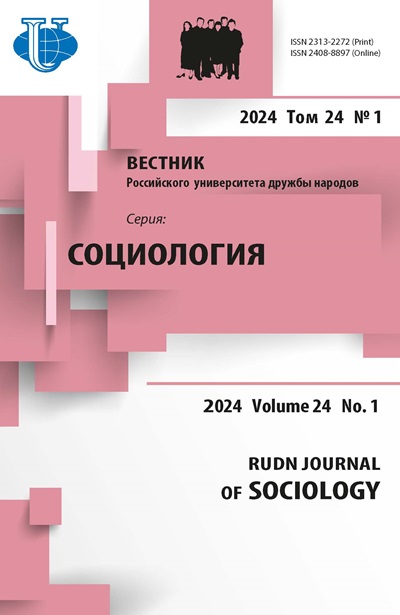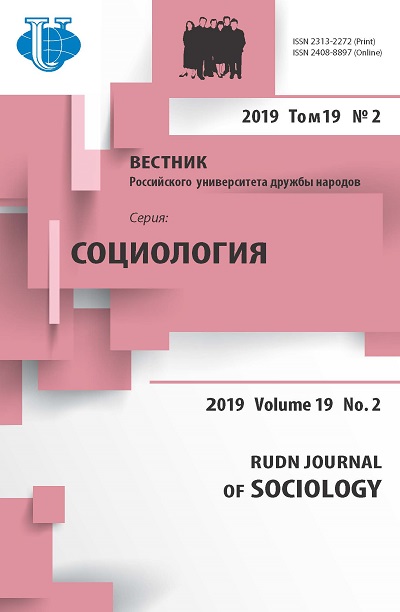Sociological aspects of the transformation of agrarian structure of Serbia in 1990-2018
- Authors: Šljukić S1, Šljukić M1
-
Affiliations:
- University of Novi Sad
- Issue: Vol 19, No 2 (2019)
- Pages: 235-243
- Section: Sociology in Serbia
- URL: https://journals.rudn.ru/sociology/article/view/21097
- DOI: https://doi.org/10.22363/2313-2272-2019-19-2-235-243
Cite item
Full Text
Abstract
One of the constitutive elements of former socialist societies that suffered radical transformations in recent decades of ‘the transition’ is certainly the agrarian structure. The authors focus on the sociological aspects of the Serbian agrarian structure transformation from the breakdown of the socialist system to the present day. The first phase of changes (1990-2000) created an environment and prerequisites for the differentiation of peasantry that continues until the present day. The second phase (2001-2012) is characterized by the appearance of large agricultural enterprises that emerged primarily as a result of privatization. During the third phase (2013-) Serbia has been drawn into the global process of ‘land grabbing’. The authors argue that in agriculture, instead of the middle class consisting of farmers, the country got a very differentiated peasantry opposing the large enterprises; and this situation is typical for post-socialist states due to three interrelated reasons: the new social-economic order was not built on the ruins of socialism but rather from the ruins; different actors within the Serbian society pursued their particular interests in the process of changes and followed demagogical declarative instructions from external experts, especially from the West; new political elites did not strive to build ex-socialist states according to their own model but rather met the needs and carried out the plans of their governments and companies, i.e. the term ‘periferization’ should be used instead of the term ‘transition’. In the final part of the paper, the authors try to answer the question why the transitional expectations regarding agrarian structural transformation did not come true, and the institutional framework for the majority of farmers working on the medium-size lands was not created. The authors also try to predict the upcoming possible alterations within the agrarian structure of the Republic of Serbia.
Keywords
About the authors
S Šljukić
University of Novi Sad
Email: srdjan.sljukic@ff.uns.ac.rs
- Dr. Zorana Đinđića, 2, Novi Sad, Serbia, 21000
M Šljukić
University of Novi Sad
Email: srdjan.sljukic@ff.uns.ac.rs
- Dr. Zorana Đinđića, 2, Novi Sad, Serbia, 21000
References
- Agriculture in the Republic of Serbia. Book 1. Beograd; 2013 (In Serbian).
- Arabs take over PKB. Telegraf. 14.09.2018 (In Serbian).
- Braun von J., Meinzen-Dick R. “Land grabbing” by foreign investors in developing countries: risks and opportunities. 2009. http://www.landcoalition.org/sites/default/files/documents/ resources/ifpri_land_grabbing_apr_09-2.pdf.
- Bunkus R., Theesfeld I. Land grabbing in Europe? Socio-cultural externalities of large-scale land acquisitions in East Germany. Land. 2018; 7 (3).
- Gulan B. The Fate of Confiscated Property. Novo Miloševo; 2015 (In Serbian).
- Halamska M. The evolution of family farms in Poland: Present time and the weight of the past. Eastern European Coutryside. 2016; 22.
- Hartvigsen M. Land reform in Eastern and Central Europe after 1989 and its outcome in the form of farm structures and land fragmentation. FAO; 2013. http://www.fao.org/3/a-aq097e.pdf.
- Investments in weeds have grown. Vreme. 11.08.2016 (In Serbian).
- Kay S., Peuch J., Franco J. Extent of farmland grabbing in the EU. 2015. http://www.europarl.europa.eu/RegData/etudes/STUD/2015/540369/IPOL_STU(2015) 540369_EN.pdf.
- Lazić M. System and its Failure: Breakdown of Socialism and the Structures of the Yugoslav Society. Beograd; 1994 (In Serbian).
- Lazić M. Waiting for Capitalism. Beograd; 2011 (In Serbian).
- Macours K., Swinnen J. Patterns of agrarian transition. Economic Development and Cultural Change. 2002; 50 (2).
- Martinez-Alier J., Temper L., Munguti S. et al. The many faces of land grabbing. Cases from Africa and Latin America. EJOLT Report No. 10. 2014. http://www.ejolt.org/wordpress/wp-content/uploads/2014/03/140305_EJOLT10.pdf.
- Mathijs E., Swinnen J. The economics of agricultural decollectivization in East Central Europe and the former Soviet Union. Economic Development and Cultural Change. 1998; 47 (1).
- Nedelković М. Characteristics of the privatization of social agricultural enterprises. Agroekonomika. 2019 (In print) (In Serbian).
- Ploeg van der J., Franco J., Borras Jr.S. Land concentration and land grabbing in Europe: A preliminary analysis. Canadian Journal of Development Studies. 2015; 36 (2).
- Popov Ј. Drama in Vojvodina Village (1945-1952). Novi Sad; 2002 (In Serbian).
- Šljukić S., Јаnkоvić D. Village in the Sociological Mirror. Novi Sad; 2015 (In Serbian).
- Šljukić S. Agriculture and the changes of the social structure: The case of Serbia. Sociologija. 2006; 48 (2).
- Šljukić S. Peasant and Cooperatives in the Plain. Novi Sad; 2009 (In Serbian).
- Šljukić S. Sociological aspects of peasant cooperation in post-socialist Romania. New Europe College Regional Program Yearbook 2001-2002. Ed. by I. Vainovski-Mihai. Bucharest; 2002.
- Šljukić S., Šljukić М. Land and People. Novi Sad; 2012 (In Serbian).
- Spoor M. Agrarian reform and transition: What can we learn from “the East”? Journal of Peasant Studies. 2012; 39 (1).
- Stark D. Recombinant property in Eastern European capitalism. American Journal of Sociology. 1996; 101 (4).
- Stark D., Bruszt L. One way or multiple paths for a comparative sociology of East European capitalism. American Journal of Sociology. 2001; 106: (4).














